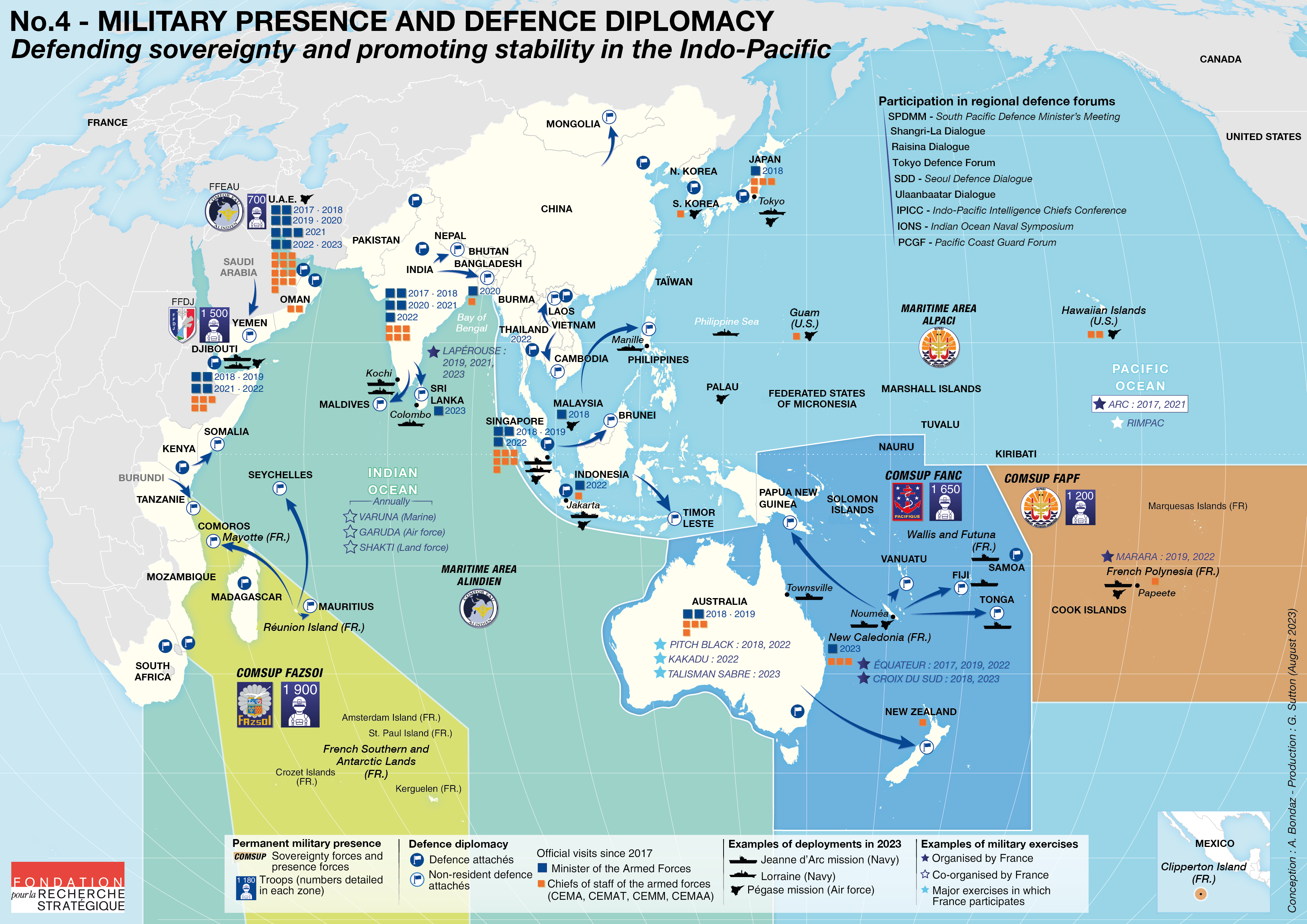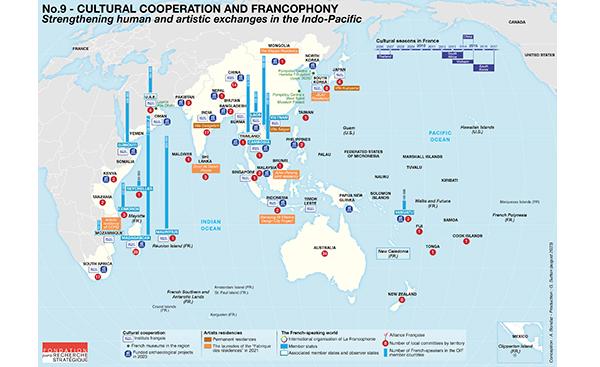Fact sheet No.4: Military presence and defence diplomacy Defending sovereignty and promoting stability in the Indo-Pacific region
Military tensions in the Indo-Pacific have increased in recent decades, against a backdrop of strategic rivalries, territorial disputes, nuclear proliferation and soaring military budgets. At nearly 300 billion dollars, China spends more on defence than all the other Indo-Pacific countries put together, enabling it to undertake massive naval rearmament.
As an Indo-Pacific power with its overseas territories and associated exclusive economic zones (see Fact sheet No.1 – Overseas Territories), France defends its sovereignty interests there through 7,000 permanently deployed personnel and five military commands. More broadly, the first pillar of France’s strategy – security and defence – is ensured by an extensive defence diplomatic network, recurrent military exercises and increasingly large-scale force projections, such as the Air and Space Force’s unprecedented PEGASE mission in 2023.
PERMANENT MILITARY PRESENCE
French interests are defended (see Fact sheet No.2 – Demographics and political representation) by five military commands, divided between three sovereignty forces – in Réunion and Mayotte (FAZSOI), New Caledonia (FANC) and French Polynesia (FAPF) – and two presence forces in the United Arab Emirates (FFEAU) and Djibouti (FFDj), which provide a permanent presence in the northern Indian Ocean. In addition, the admiral commanding the FAPF is commander of the Asia-Pacific maritime zone (ALPACI), and the admiral commanding the FFEAU is commander of the Indian Ocean maritime zone (ALINDIEN).
The military capabilities of the armed forces are limited if one considers the region’s scale, but they are currently being modernised. Six new overseas patrol boats (POM) will be deployed by 2025, two more than the current number, and the replacement of the Falcon 200 Gardian will enhance surveillance and maritime situational awareness capabilities. Designed for high seas and long distances (up to 30 days at sea within a radius of 5,500 nautical miles, or 10,000 km, with a much greater carrying capacity – 1,300 tons vs. 400 tons), these patrol boats will also be equipped with drones.
In addition, the French Military Program Law (2024-2030) calls for the construction of three BATRAL-type force projection ships. As announced by the President of the Republic in Nouméa in July 2023, 200 military personnel will reinforce the FANC.
The FAZSOI is the largest in terms of numbers, with over 1,900 personnel, including 1,600 military personnel, and are unique in that they operate a single vessel, the polar patrol vessel Astrolabe, the result of a partnership with the French Southern and Antarctic Territories (TAAF) and the French Polar Institute Paul-Émile Victor. The only Foreign Legion detachment in the Indo-Pacific is in Mayotte.
UNBALANCED DEFENCE DIPLOMACY
Complementing the diplomatic network (see Fact sheet No.3 – Diplomatic network and official visits), the Ministry of the Armed Forces’ network in the Indo-Pacific comprises nineteen defence missions covering fourty countries. Some of the defence attachés are non-resident, such as those for Mongolia and the Philippines, based in Beijing, and those for the Comoros, Mauritius and the Seychelles, based in Réunion. In liaison with the Directorate General for International Relations and Strategy (DGRIS), the defence attachés coordinate bilateral and multilateral defence relations. The armed forces interact regularly with their counterparts, as demonstrated by the recent signing of a cooperation plan between the FANC and the Australian Department of Defence.
Visits to the Indo-Pacific by the Minister of the Armed Forces and the Chiefs of Staff (CEMA, CEMAT, CEMN and CEMAAE) bear witness to priority partnerships, particularly in terms of arms exports. The United Arab Emirates, which has acquired 80 Rafales, the largest arms contract in the history of the Fifth Republic, stands out for a record number of visits since 2017: nine by the Minister and thirteen by the Chiefs of Staff. Next come India and Djibouti, as well as Singapore, due to the Minister’s presence at the annual Shangri-La conference. East Africa, Southeast Asia and the Pacific remain little visited, as do the French territories.
Defence diplomacy in the region is active. There are ministerial consultations of foreign and defence ministers, known as 2+2, with Japan, Australia, Djibouti and Indonesia. France is a member of the Indian Ocean Naval Symposium (IONS) and the South Pacific Defence Ministers’ Meeting (SPDMM), which it will host in Nouméa in December 2023. France has been admitted as an observer to the Asean Defence Ministers’ Meeting Plus (ADMM+) in 2023. Officials and experts also take part in the region’s many annual conferences: Tokyo Defence Forum, Seoul Defence Dialogue, Ulaanbaatar Dialogue, Raisina Dialogue in New Delhi, etc.
FREQUENT DEPLOYMENTS
The Navy deploys regularly to the Indo-Pacific. This is evidenced by the more than 500 port calls made to the FFEAU naval base in Abu Dhabi since its opening in 2009. These allow, among other things, to reaffirm that freedom of navigation, particularly in the South China Sea and Taiwan Strait, must be exercised without hindrance.
In early 2023, the carrier group carried out a number of missions in the Indian Ocean with regional partners, including Djibouti, Oman, the United Arab Emirates and India. The aircraft carrier Charles de Gaulle, a major vehicle for power projection and air-sea control, has never been deployed in the Pacific Ocean, but made a historic stopover in Singapore in 2019, during which France's Indo-Pacific defence strategy was presented.
Every year, the JEANNE D'ARC Mission circumnavigates the globe with around a hundred student officers on board. In 2023, the amphibious helicopter carrier Dixmude, the frigate La Fayette and their 800 sailors and soldiers made stopovers in Djibouti, Cochin in India, Jakarta in Indonesia, Singapore, Townsville in Australia, Nouméa, Fiji, Tonga, Papeete and as far as the Clipperton EEZ. Notably, missions to combat illicit trafficking in the Indian Ocean and fisheries policing in the Pacific Ocean were organized. (see Fact sheet No.5 - Security and police cooperation).
The new Lorraine multi-mission air defence frigate made its first deployment to the region this year, joining the US Carrier Strike Group No.5 for two weeks and took part in exercises with Japan and Canada.
Since 2021, the French Air Force has also been steadily deploying more and more air assets in the region. After the HEIFARA deployment in 2021, SHIKRA and PÉGASE in 2022, the PÉGASE deployment in summer 2023 was historic. A record number of aircraft - 10 Rafales, 5 A330 MRTT Phénix and 4 A400M Atlas - made multiple strategic stopovers, valued by a dozen partners in the Arabian Peninsula, the Indian Ocean and the Pacific, with a stopover in South Korea for the first time.
REGULAR EXERCISES AND EXCHANGES
The French armed forces organise and take part in numerous military exercises to deepen bilateral and multilateral relations, strengthen interoperability and share know-how, particularly in the field of humanitarian assistance following natural disasters (see Fact sheet No.7 - Humanitarian Aid, crises and natural disasters). In this area, the South Cross exercises, organised in 2018 and 2023, have demonstrated the FANC’s ability to plan and conduct a large-scale joint, interdepartmental and multinational operation in the Pacific, bringing together more than 3,000 participants from nineteen nations. The Equateur Marara exercise, organised by the FAPF in 2019 and 2022, had the same purpose.
Each year, exercises Varuna (Navy), Garuda (Air Force and Space) and Shakti (Army) are organised with India. Bilateral exercises are frequent, such as the FFDj’s Amitié exercise with the Djibouti armed forces, the FFEAU’s Tiger Eel exercise with the UAE naval forces, and the FAZSOI’s Oxide exercise with the South African armed forces. The French armed forces also take part in multilateral military exercises such as RIMPAC 2022, the largest naval exercise in the world, which brought together nearly 25,000 military personnel from twenty-six different countries, or exercises Pitch Black, Kakadu and Talisman Sabre in Australia.
Higher military education is also a vehicle for exchanges. The École de Guerre welcomes many officers from the region, and since 2020, the IHEDN has annually organised an international session for the Indo-Pacific (SIIP).


Fact sheet No.4: Military presence and defence diplomacy Defending sovereignty and promoting stability in the Indo-Pacific region
La France en Indo-Pacifique n°04/2023
Antoine Bondaz,
December 18, 2023






